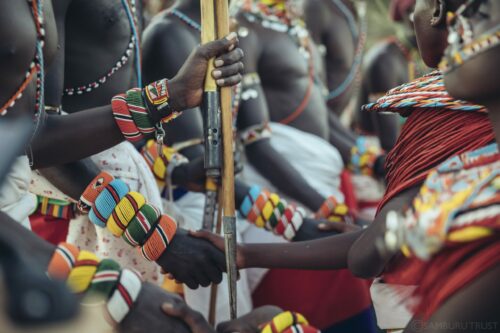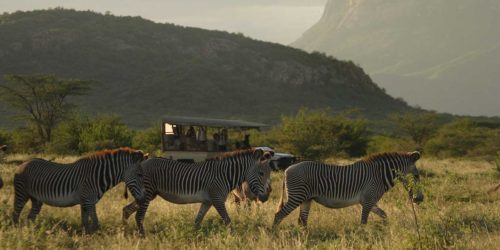When planning to go on safari in Kenya, your first question may be, “When is the best time to visit?”
The best time to visit Kenya: the short answer
While there is no “bad” time to go on safari in Kenya, July, August, and September during the dry season are conventionally recommended to travelers looking for iconic Great Migration moments.
In addition to potentially witnessing a dramatic river crossing, these are the months when the largest herds of wildebeest and zebra—and the predators who stalk them—are amassing throughout the Maasai Mara. However, travelers shouldn’t shy away from visiting outside of peak season when crowds thin and intermittent showers paint the landscape in shades of verdant green.
The best time to visit Kenya: the long answer
Kenya straddles the equator, meaning the average year-round temperature fluctuates just a handful of degrees. Warmer months hover in the low 80s (~27°C), while the cooler months are still pleasant in the mid-70s (~24°C). For this reason, it’s practical for travelers to think in terms of wet and dry seasons instead and to consider the elevation of the region they are visiting.
Dry seasons in Kenya typically run June to October and December to February. Mid-March through May, October, and November are Kenya’s wettest months. April and May see the most rainfall, earning them the moniker “the long rains.” October and November dump a little less volume and, resultantly, are referred to as “the short rains.” Travelers shouldn’t be automatically turned off by a wet season safari. As a trend, bouts of rainfall commonly arrive as an intense downpour and then promptly ease off or stop after an hour or so. A luxury Kenya safari during secret season has other perks, too.
Otherwise, at sea level, Kenya’s coastal climate is tropical and moderated by the ocean. There’s higher humidity than the inland plains, but the difference between daily lows and daily highs is not as severe. As you move inland and gain elevation, the climate becomes increasingly arid, and some areas are nearly absent of rainfall. Here, temperatures swing widely between hot afternoon highs and chilly evening lows.
In terms of the calendar year, it’s helpful to know that Kenya shares its seasons with the Southern Hemisphere. Warmer months (“summer”) span December to March; cooler months (“winter”) are June through September.
When to go to Kenya may depend on reasons entirely unrelated to climate. Factors like preferred wildlife viewing, the school calendar, and the booking availability of preferred lodgings (these are the properties we think are the best luxury safari lodges in Kenya) may prove just as important to the decision-making process. What’s more, some people prefer to travel during the shoulder seasons to take advantage of lower rates or to shirk the crowds that can assemble in Kenya’s most popular parks during peak season.
When to safari in Kenya: a month-by-month guide

Visiting Kenya in January
Season: Dry; shoulder season
Average temperature: 80°F / 25.5°C
Average precipitation: 1.2 inches / 32 mm
The weather is warm and quite dry; game viewing is ample in the Maasai Mara, and migratory birds from Europe and northern Africa make for great birdwatching. It’s a fantastic time to cool off on the Kenyan Coast and enjoy the powder-fine sandy beaches. January and February offer the clearest waters, ideal for snorkeling and diving. At this time, Rift Valley lakes are flush with birdlife through to February.
Visiting Kenya in February
Season: Dry: shoulder season
Average temperature: 79°F / 26.2°C
Average precipitation: 1 inch / 25 mm
Masses of wildebeest are largely concentrated on the short grassy plains of Tanzania‘s southern Serengeti National Park, but the resident game in the Maasai Mara is congregating at water holes thanks to low precipitation—making them easier to find. In the latter part of the month, wildlife like zebra, antelope, gazelle, impala, and warthog begin giving birth. February, and the months that neighbor it, are a lovely time to hike Mount Kenya or Mount Kilimanjaro in neighboring Tanzania (and highly visible from Amboseli). On the coast, it is peak season for whale sharks, and water visibility is excellent.
Visiting Kenya in March
Season: Transitioning to wet; low season
Average temperature: 80°F / 26.7°C
Average precipitation: 2.4 inches / 63 mm
Newborns are arriving all month, which warms the hearts of onlooking safari-goers. Consequently, it’s also the time we see high predator action. Temperatures remain high, especially inland. Generally, we are seeing rains start in mid-March and travelers can snag a deal on secret season rates.
Visiting Kenya in April
Season: Wet: low season
Average temperature: 79°F / 26.1°C
Average precipitation: 5.2 inches / 134 mm
April welcomes the start of “the long rains,” which begin to soak dirt roads. On the flip side, the dust that can blanket a safari experience settles—which photographers will very much appreciate. The storms that roll through make for moody savannah backdrops. With ample water sources, animals disperse.
Visiting Kenya in May
Season: Transitioning to dry; low season
Average temperature: 77°F / 25°C
Average precipitation: 3.6 inches / 92 mm
The thirsty landscape is now quenched and painted in emerald hues. An explosion of growth offers wildlife ample cover, meaning animals are better able to camouflage into the landscape. Extraordinary Journeys safari experts love recommending the latter half of May as a travel sweet spot when rates are lower and the plains are virtually crowd-free.
Visiting Kenya in June
Season: Dry; shoulder season
Average temperature: 75°F / 24°C
Average precipitation: 1.4 inches / 35 mm
The end of rainy season dries out Tanzania’s Serengeti, prompting herds of wildebeest to begin their Great Migration north towards Kenya. Long grasses thrive if the rains have been plentiful, obscuring game viewing—not that the animals seeking protective cover mind at all. Once again, wildlife begins to congregate at permanent water sources. If travelers are a bit early for Great Migration masses, they might instead encounter the separate Loita Migration of wildebeest and zebra moving east-west from the Loita Hills. Smaller in membership—though still numbering in the hundreds of thousands—travelers who visit in June have a good shot at seeing massive herds of wildebeest as they move between Ol Kinyei, Naboisho, and the Olare Motorogi Conservancies adjacent to the Mara.
June through September are great months to be trekking Mount Kilimanjaro and Mount Kenya.
Our safari experts love recommending June as a travel sweet spot before rates peak next month and before the plains swell with safari-goers in summer.
Visiting in July
Season: Dry: peak season
Average temperature: 74°F / 23.4°C
Average precipitation: 1.25 inches / 32 mm
By this time, most kids are out of school and families are on holiday. It’s peak season through to August—so hopefully you’ve booked your trip 12 to 18 months in advance to secure your preferred luxury Kenya safari accommodations. The wildebeest are moving en masse into the Maasai Mara and perilously crossing the Mara River in volumes. The temperatures are lovely, but travelers will want to layer up after dark. With clear skies and long sunny days, July is a fantastic month to safari in Kenya.
Visiting in August
Season: Dry; peak season
Average temperature: 75°F / 23.8°C
Average precipitation: 1.4 inches / 35 mm
The plains are busy, the weather is comfortable, precipitation is low, and rates are at their highest. The Great Migration is considered to be in full swing. Wildlife continues to seek out water sources, making rivers and water holes great entertainment for safari-goers. The Mara Reserve can see some tourist congestion, but Extraordinary Journeys safari experts have an arsenal of advice and camp recommendations to ensure guests make the most of their peak-season safari. On the coast, low humidity and dry weather invite sunseekers. We are big fans of Lamu Island.
Visiting Kenya in September
Season: Dry; peak season
Average temperature: 76°F / 24.5°C
Average precipitation: 1.1 inches / 28 mm
September largely repeats the weather of August, but children and youth return to school, thinning out the number of travelers on the plains. It’s still warm and dry—pleasant conditions for ample game viewing on the plains. July, August, and September are a good time to catch flamingos congregating on the shores of Lake Nakuru.
Visiting Kenya in October
Season: Wet; high season
Average temperature: 77.5°F / 25.3°C
Average precipitation: 3 inches / 77 mm
It’s warming up with each day that passes in October. Birds migrating from Europe begin arriving in Kenya. In the latter half of the month, rainfall picks up. Depending on when those rains started, wildebeest and zebra will be making their way back to Tanzania.
Visiting Kenya in November
Season: Wet; low season
Average temperature: 77°F / 25.1°C
Average precipitation: 4.3 inches / 110 mm
“The short rains” have begun. Some camps on the Laikipia Plateau will close. It’s a great time to enjoy a quiet safari while snagging a good deal. In the Mara, after the first couple of rainfalls, the grass turns from a tawny brown to green. Watch storms roll through in the evenings, darkening the sky in broad strokes of gray and deep blue out on the horizon. It’s a moody portrait and kaleidoscope of colors that beckons to photographers.
Visiting Kenya in December
Season: Dry; shoulder season
Average temperature: 77°F / 24.9°C
Average precipitation: 2.4 inches / 60 mm
The last month of the year can be quite hot in Samburu—though the Mara and Laikipia remain comfortable—and the earlier half of December can observe bouts of rainfall. Though the wildebeest are away now, resident wildlife viewing is fantastic, as is birdwatching. Thanks to the short rains, the landscapes are painted green once again. For a quiet Christmas trip, consider a long stay in an exclusive-use safari camp or book into a smaller, boutique camp on a conservancy.
Weather data sourced from ClimateKnowledgePortal
Some of our favorite luxury Kenya safari itineraries

- Itinerary
Kenya: Barefoot Luxury & Adventure
Iconic safari experiences and authentic accommodation

- Itinerary
Kenya: Culture & Adventure Across the Plains
Get out of your vehicle and explore on foot

- Itinerary
9-Day Fly-in Kenya Safari
Incredible Game, Conservation, and Community Upliftment
Plan your Trip
Ready to start planning your own incredible adventure? We make the process stress-free and enjoyable.
